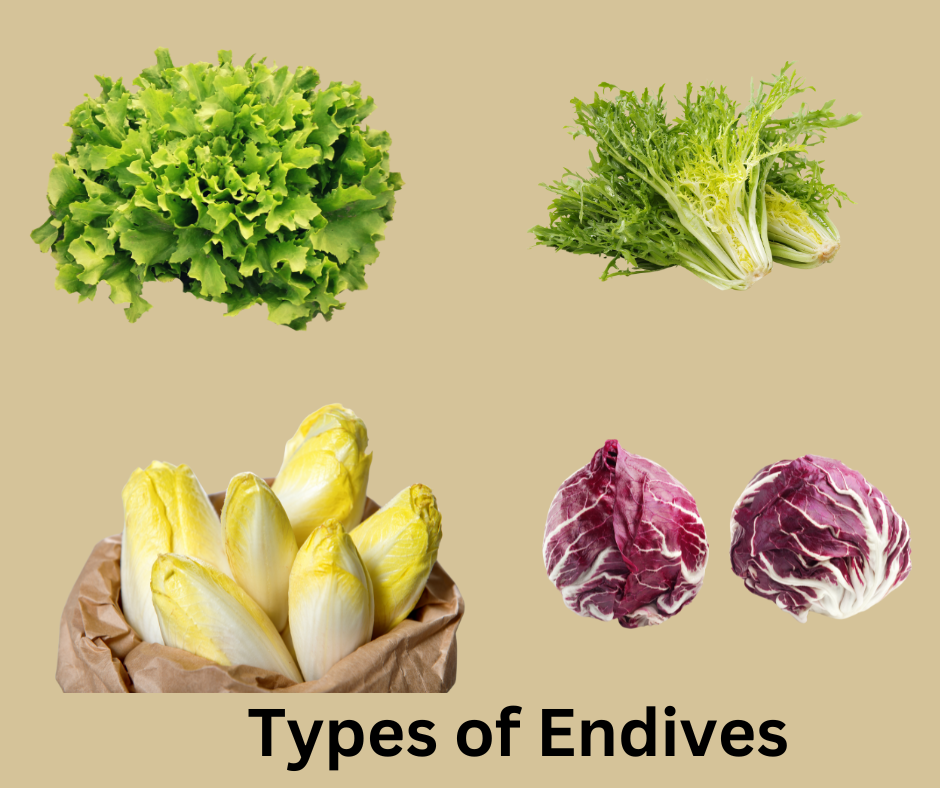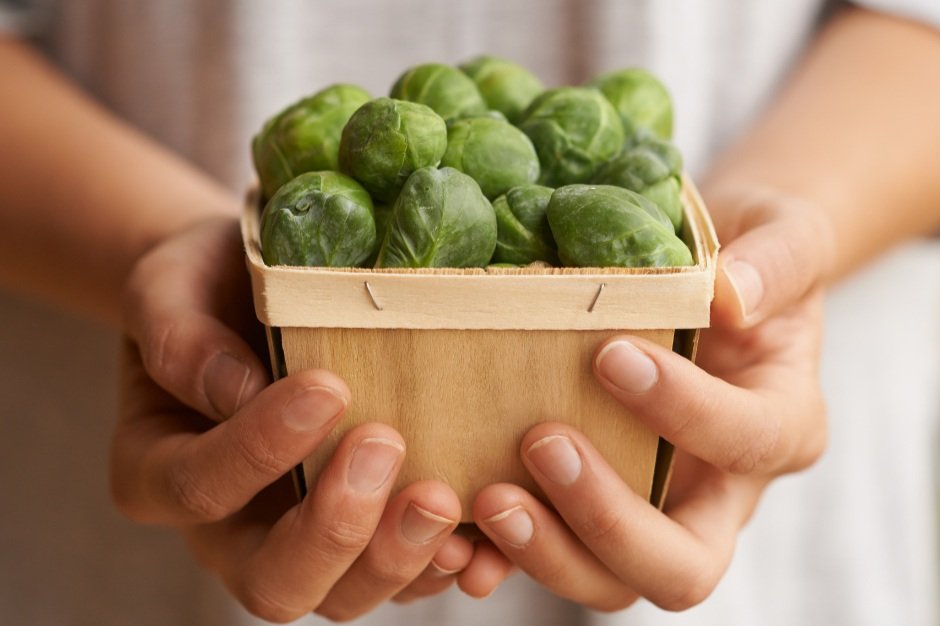Endive is a versatile and nutritious leafy green vegetable that is a great addition to any organic garden. It belongs to the chicory family and is grown for its crisp, bitter leaves.
Endive includes several plants in the Asteraceae family including Crispy Endive (Cichorium endivia), Belgian Endive (Cichorium intybus var. foliosum), and Radicchio (Cichorium intybus). We also refer to them as Chicory and they have a sharp often bitter taste.
We will talk about growing all three in this article!
From top left going clockwise: Crispy Endive, Frisee type, Radicchio, and Belgium Endive.
Types of Endive
Crispy Endive (Cichorium endivia)
Crispy endive, also known as escarole or frisee, is a leafy green vegetable with a slightly bitter flavor and a crisp texture. Its elongated leaves form a tight, compact head with a pale green or white color.
Endive comes in two main varieties: curly endive, with finely serrated leaves, and escarole (ad), with broader, flatter leaves. Crispy endive can be enjoyed raw or cooked, offering versatility in various culinary applications.
Belgian Endive (Cichorium intybus var. foliosum)
Belgian Endive is a unique and versatile vegetable that has gained popularity in the culinary world. Considered a European delicacy it is known for its distinct, elongated shape and pale color.
What makes Belgian Endive particularly interesting is its cultivation process. Initially, the plant is grown in the field, and its roots are harvested. The roots are then brought indoors, where they undergo a two-step process involving chilling and darkness.
This triggers the growth of compact, tightly packed leaves, resulting in the formation of the characteristic cigar-shaped heads. With a slightly bitter and crisp taste, Belgian Endive adds a delightful texture and flavor to salads, appetizers, and various dishes.
Radicchio (Cichorium intybus)
Radicchio(ad) is known for its distinctive deep red or purple leaves with white veins which adds a burst of color and a slightly bitter flavor to salads and various dishes. It comes in a range of compact round heads to looser lettuce-like heads.
Varieties
Curlesi Crispy Endive
You know how in our Zone 6 spring tends to morph into summer in 2.5 seconds? I typically run around putting shade cloth on my cool-weather plants!
Curlesi is slower to bolt and will keep growing in this fast seasonal transition. It has pretty green frilly leaves that will self-blanch. 52 days to maturity. Open Pollinated.
Très Fine Maraîchère Olesh Endive
This is the standard in Endive. Developed in France it has a mild bitter taste with sweet overtones. Leaves are green and classically frisée. 42 days. Open Pollinated.
Palla di Fuoco Rossa Radicchio
A traditional Chioggia-type from Italy this radicchio has a round burgundy head. Resembles a compact lettuce plant. Palla di Fuoco Rossa means ‘ball of red fire. 85 days. Open Pollinated.
Leonardo Radicchio
Forms a compact reddish-purple 4–5" head that looks like a small cabbage. Great for a fall garden. 65 days to maturity. F1 Hybrid.
Bingo Belgian Endive
Good uniform shape with an early to intermediate forcing period. store and force well into winter. Resistant to powdery mildew.
Planting
Endive is a cool-weather crop. It's best to plant endive in the early spring or late summer, as it thrives in cooler temperatures. Aim to plant your endive when the soil temperature is consistently between 59°F and 77°F.
Radicchio is a bit hardier than leaf endive and can be sown when soil temps reach 50F.
Choose a location in your garden that receives full sun or partial shade. The soil should be well-draining, rich in organic matter, and have a slightly acidic to neutral pH level (6.0-6.8).
Very tolerant of fall frosts down to the 20s.
Direct Sow
You can start endive from seeds directly sown into the ground or by transplanting seedlings. If starting from seeds, sow them 1/2 inch deep and 4-6 inches apart. If using seedlings, plant them at the same spacing.
Transplant
Endive makes a good fall crop as well and I find it’s best to use transplants because you can germinate them in a cool location.
Sow in 48 trays or 3-inch jiffy pots in a loose soil mix with some extra vermiculite.
The ideal germination temp is 68–72°F (20–22°C), but can germinate as low as 59°F (15°C).
If you lack a basement or greenhouse space like me, you can force Belgium Endive outside under a heavy dark landscaping fabric.
Unique Belgium Endive Growing
Belgium endive is a unique two-step process. The first step is similar to growing other endives. You just directly sow the seeds after the first frost date and allow the greens to grow.
They will produce nice upright green leaves. However, You are actually growing for root development so allow the plants to mature into the fall.
The second step is where it gets interesting! You harvest them in fall, cut off the leaves and keep the roots.
Cut off leaves but leave an inch around the growing bud where the leaf emerges from the roots.
Store the roots in dark cold place for two weeks. Don’t wash the roots. Strive for 32°F/0°C with 96–98% humidity.
Prepare the Containers:
Fill the containers with a sandy potting mix, leaving some space at the top. Plant the Belgium Endive roots about 6-8 inches apart. Bury them in the soil, leaving the crown just above the surface. Water the soil so it is all moist.
You can also grow the roots in water. Take the roots and line them up vertically in a tote or other container that will hold water. For an urban grower, you can also place them in a vase you use to force flower bulbs. After placing the roots in the tote you will add about 3 inches of water.
Make sure you have a completely dark spot for them. This step is crucial, as it induces the endive to form compact heads in the absence of light.
Your location should be between 50-60°F (10-15°C). A basement or root cellar works well for this purpose. A new set of leaves will grow making an elongated compact head that is a pale yellow color. (there is also a pink variety)
Check the moisture level regularly. The soil should be kept consistently moist but not waterlogged.
After about 30-60 days, the Belgium Endive should be ready for harvest. Remove the covers and cut the heads at the base.
Care
Watering
Keep the soil consistently moist but not waterlogged. Water your endive plants deeply once or twice a week, allowing the top inch of soil to dry between waterings. Mulching around the plants can help to retain moisture and prevent weeds.
Fertilization
Before planting, amend the soil with compost or well-rotted manure. They are not big nitrogen feeders so dig in plenty of well-rotted compost before planting. I don’t use any additional fertilizers unless plants look puny or are having pest problems.
Pest and Disease Control
Keep an eye out for common pests such as aphids, snails, and slugs. Use organic insecticidal soap or neem oil to control infestations. Endive is generally resistant to diseases, especially when grown in healthy, well-drained soil.
Blanching
To reduce the bitterness of endive leaves, the plants can be blanched. This involves covering the center leaves with a pot or other light-blocking material for the last 2-3 weeks before harvest. This process prevents the leaves from developing chlorophyll and becoming overly bitter.
Read my article on Growing Lettuce in Zone 6 next
Harvesting
Endive can be harvested when the leaves are mature. Harvesting can be done all at once or by picking individual leaves as needed.
Storage
After harvesting, store the endive in the refrigerator. It remains fresh for up to two weeks when stored in a plastic bag or wrapped in a damp cloth.
Ways to Use Crispy Endives
Raw Endive Salad:
Create a refreshing salad by combining sliced endive with other greens, cherry tomatoes, cucumber, and a light vinaigrette.
Endive and Citrus Salad:
Combine endive with segments of oranges or grapefruits, add some chopped mint, and dress with a citrusy vinaigrette for a zesty salad.
Braised Endive:
Braise endive in a flavorful broth or white wine until tender. This method imparts a delicate taste to the endive.
Endive and Cheese Tart:
Create a savory tart with a base of puff pastry or pie crust, topped with a mixture of sautéed endive and your favorite cheese.
Endive Smoothies:
Blend endive leaves into your favorite smoothie for an extra nutrient boost. Its slightly bitter taste pairs well with sweet fruits.
Endive Stir-Fry:
Add chopped endive to your stir-fry for a quick and nutritious addition. It maintains a pleasant crunch even when cooked.
Ways To Use Radicchio in Cooking
Salads:
Use radicchio leaves in mixed green salads for a peppery and slightly bitter flavor.
Combine radicchio with other salad greens, cherry tomatoes, and a balsamic vinaigrette for a refreshing side dish.
Grilled Radicchio
Grilled Radicchio:
Cut the radicchio into wedges, drizzle with olive oil, and grill for a few minutes on each side until it gets a smoky flavor.
Stir-Fries:
Add chopped radicchio to your favorite stir-fry for a unique crunch and flavor.
Sandwiches and Wraps:
Include radicchio leaves in sandwiches or wraps for a flavorful and textural contrast.
Roasted Radicchio:
Roast radicchio with olive oil, garlic, and herbs until it caramelizes, bringing out its natural sweetness.
Quiches and Frittatas:
Incorporate radicchio into quiches or frittatas for a unique flavor profile.
Braised Endive
Ways To Use Belgium Endive
Endive Appetizers:
Fill endive leaves with various toppings such as goat cheese, nuts, and dried fruits for elegant and bite-sized appetizers.
Endive and Apple Salad:
Combine sliced endive with chopped apples, walnuts, and a light vinaigrette for a refreshing salad.
Endive Wraps:
Use endive leaves as a substitute for tortillas or wraps. Fill them with your favorite ingredients like hummus, cheese, or smoked salmon.
Grilled or Roasted:
Cut endive in half lengthwise, drizzle with olive oil, and grill or roast until slightly caramelized. This enhances its natural sweetness.
Baked Endive with Parmesan:
Halve endives, sprinkle with Parmesan cheese, and bake until golden brown for a flavorful side dish.
Endive and Pear Pizza:
Use endive and thinly sliced pears as pizza toppings. Add blue cheese and walnuts for a gourmet touch.
Endive and Bacon Appetizers:
Wrap endive leaves with bacon and bake until crispy for a tasty appetizer.
Endive and Mushroom Risotto:
Stir chopped endive into a mushroom risotto during the last few minutes of cooking for added flavor and texture.












Daikon radishes (Raphanus sativus) are a type of Japanese radish that is commonly grown for its large, white, cylindrical root. These radishes are known for their crisp texture and mild, slightly spicy flavor.